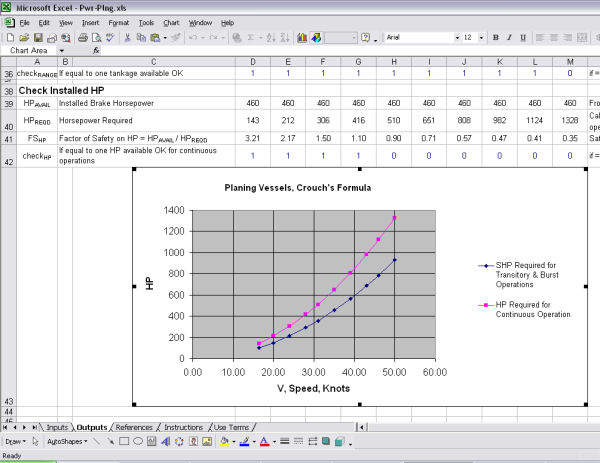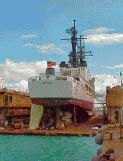|
Description:
This boilerplate spreadsheet performs planing boat powering calculations
using Crouch's formula (a planing boat power prediction method). Result graphs are
automatically generated and show speed in knots versus brake horsepower required. Because the input weight is important, this
spreadsheet is setup to conveniently calculate the vessel's weight in various
operational conditions. This template also checks to see if the
vessel will go it's intended range, if the installed horsepower is
adequate and if the stern's quarter butt exit angle permits the input
speed.
These calculations apply to planing vessels that
operate at a speed length ratios, V / LWL1/2, of 3 and greater.
Vessel's must have a aft quarter butt exit angle of 2 degrees or less for
these calculations to apply. A example drawing of this angle is
provided with the calculations.
These computations
are based on procedures described by Skene's Elements of Yacht Design and Dave Gerr's
Propeller Handbook. Unless
otherwise noted, the calculative procedures contained in this spreadsheet are
primarily adapted from Reference D. This reference is
recommended reading. The other references contain supplemental information,
but they are not required for implementation or understanding of these calculations. This template is
designed to be used with English units.
There are advantages and benefits
associated with this calculative method. First this approach saves
time. Numerous computations are automatically and quickly done on
your input data. This approach is also cost effective because the
calculations are already setup
for you. As a result your research time is minimized to familiarization of concepts when
necessary and not in time consuming procedural development activities.
Electronic
Document Type: Microsoft Excel
spreadsheet
Cost:
$25 US funds
Number of
Pages: Inputs Sheet, Output Sheet, References,
Figure and Notes Sheet, Use Terms Page and Instructions
Page.
Inputs:
Outputs:
-
For each of the input speeds the following is
output are computed by this template:
-
Effective Horse Power,
EHP
-
Brake Horse Power,
BHP
-
Continuous Horsepower,
BHP0
-
Estimated Range, nautical miles,
from fuel consumption rate and tank capacity
-
The total operational weight is automatically
computed based on light ship margin selected, cargo present, persons
aboard, voyage duration which affects stores and provisions, selected
operational tank capacities and gear on board.
-
Supplemental values like displacement
length ratio, estimated maximum possible displacement speed, estimated
fuel consumption rate, speed length ratios.
-
Calculative Checks are made for the
following criteria:
-
Check if installed horsepower will meet the required horsepower
needed for continuously operating at the speed computed. It is
important to know that If the speed involved is not a continuous
operating speed this check should be ignored. These speeds include
those used for burst mode operation (operations only for short periods at this speed) and transitory
speeds (when accelerating or decelerating towards a continuous operating
speed).
-
Check if range requirements will be meet at the speed evaluated.
If this check is met the fuel tanks are adequately sized, if not the
fuel tanks should be increased in size, but only for continuous
operating speeds.
-
Check if hull bottom aft exit angle
at quarter butt is appropriate for speed computed. If this check
is not met the bottom shape at the aft end of the hull should be
flattened more so this speed can be reached by the hull.
Recommended
Reading:
Reference A: Doug Shryverk, article entitled "Making
Sense of Engine Options," Motor Boating and Sailing, February 1977
issue. -
Reference B:
Valentine Jenkins, article entitled "Building
Fast Boats that Don't Break," Professional Boatbuilder Magazine,
Oct.-Nov. 1997 issue.
-
Reference C:
Lorne Campbell, Letter to Editor
regarding article entitled "Building Fast Boats that Don't Break," by
Valentine Jenkins, Professional Boatbuilder Magazine, Oct.-Nov. 1997
issue.
-
Reference D: Dave Gerr, Propeller Handbook,
International Marine, 1989, Camden, Maine.
-
Reference E: Dave Gerr, Nature of Boats,
International Marine, 1995, Camden, Maine.
-
Reference F: John Teale, article
entitled "Teale on Trawlers," Motor Boating and Sailing, June
1981 issue.
-
Reference G: Robert P. Beebe, article
entitled "Trawlers - Designing by the Numbers," Motor Boating and
Sailing, January 1977 issue.
-
Reference H: Alfred D. Isaacson,
paper entitled "Sewage Polution Control: A Guide for the Ship Owner &
Design," SNAME Marine Technology, July 1977 issue..
-
Reference I: S9086-C6-STM-010/CH-096R1 "Naval Ships'
Technical Manual Chapter 096 Weights & Stability," NAVSEA, 2 August
1996.
-
Reference J: Detroit Allison Diesel,
article entitled "Calculating Hull Speed," Motor Boating and
Sailing, February 1978 issue.
-
Reference K: Robert P. Beebe and
James F. Leishman, Voyaging Under Power, Third Edition,
International Marine, 1994, Camden, Maine.
Terms:
Prior to purchase, read our End
User License Terms.
Important Notice to European Union Buyers:
Due to changes in international law, we no longer accept
purchases from any individuals located within an EU country.
However, businesses located within the EU are allowed to make
purchases, provided that they make the VAT payments for any imported
items purchased electronically. These EU businesses must
specify their VAT number in the memo section on the Paypal
payment pages. These changes are effective as of July 1, 2008,
and were modified for EU businesses on April 9, 2010.
Download
Now: click the following hyperlink to pay
$25 fee and then immediately download the zip file containing the template.
Minimum
System Requirements: Windows 95/98/NT/2000/XP/Vista/Windows7
Sample:
A sample of an output page is shown below.

|



